Wanli Ouyang
School of Electrical and Information Engineering, The University of Sydney, Australia
Understand Before You Generate: Self-Guided Training for Autoregressive Image Generation
Sep 18, 2025Abstract:Recent studies have demonstrated the importance of high-quality visual representations in image generation and have highlighted the limitations of generative models in image understanding. As a generative paradigm originally designed for natural language, autoregressive models face similar challenges. In this work, we present the first systematic investigation into the mechanisms of applying the next-token prediction paradigm to the visual domain. We identify three key properties that hinder the learning of high-level visual semantics: local and conditional dependence, inter-step semantic inconsistency, and spatial invariance deficiency. We show that these issues can be effectively addressed by introducing self-supervised objectives during training, leading to a novel training framework, Self-guided Training for AutoRegressive models (ST-AR). Without relying on pre-trained representation models, ST-AR significantly enhances the image understanding ability of autoregressive models and leads to improved generation quality. Specifically, ST-AR brings approximately 42% FID improvement for LlamaGen-L and 49% FID improvement for LlamaGen-XL, while maintaining the same sampling strategy.
ChemBOMAS: Accelerated BO in Chemistry with LLM-Enhanced Multi-Agent System
Sep 10, 2025Abstract:The efficiency of Bayesian optimization (BO) in chemistry is often hindered by sparse experimental data and complex reaction mechanisms. To overcome these limitations, we introduce ChemBOMAS, a new framework named LLM-Enhanced Multi-Agent System for accelerating BO in chemistry. ChemBOMAS's optimization process is enhanced by LLMs and synergistically employs two strategies: knowledge-driven coarse-grained optimization and data-driven fine-grained optimization. First, in the knowledge-driven coarse-grained optimization stage, LLMs intelligently decompose the vast search space by reasoning over existing chemical knowledge to identify promising candidate regions. Subsequently, in the data-driven fine-grained optimization stage, LLMs enhance the BO process within these candidate regions by generating pseudo-data points, thereby improving data utilization efficiency and accelerating convergence. Benchmark evaluations** further confirm that ChemBOMAS significantly enhances optimization effectiveness and efficiency compared to various BO algorithms. Importantly, the practical utility of ChemBOMAS was validated through wet-lab experiments conducted under pharmaceutical industry protocols, targeting conditional optimization for a previously unreported and challenging chemical reaction. In the wet experiment, ChemBOMAS achieved an optimal objective value of 96%. This was substantially higher than the 15% achieved by domain experts. This real-world success, together with strong performance on benchmark evaluations, highlights ChemBOMAS as a powerful tool to accelerate chemical discovery.
Interleaving Reasoning for Better Text-to-Image Generation
Sep 09, 2025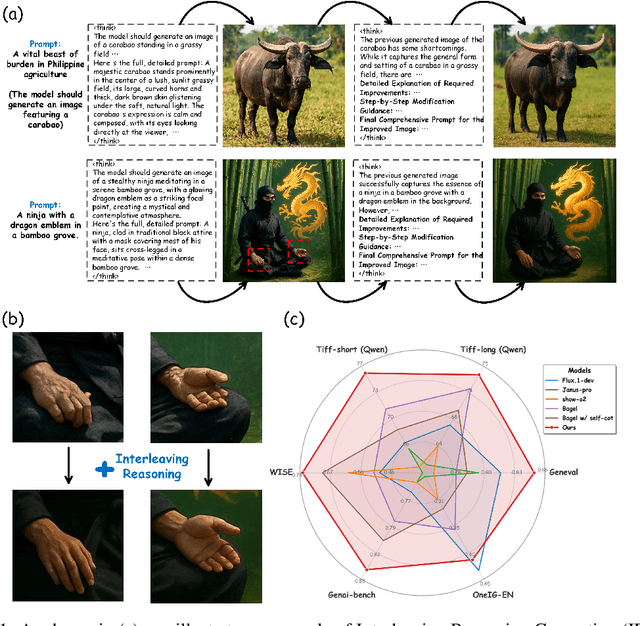
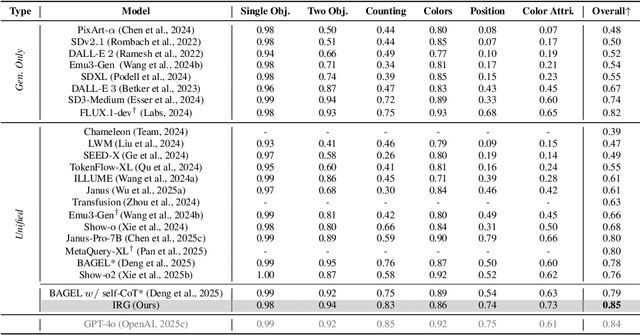

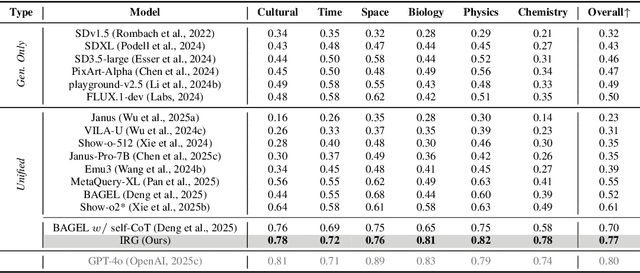
Abstract:Unified multimodal understanding and generation models recently have achieve significant improvement in image generation capability, yet a large gap remains in instruction following and detail preservation compared to systems that tightly couple comprehension with generation such as GPT-4o. Motivated by recent advances in interleaving reasoning, we explore whether such reasoning can further improve Text-to-Image (T2I) generation. We introduce Interleaving Reasoning Generation (IRG), a framework that alternates between text-based thinking and image synthesis: the model first produces a text-based thinking to guide an initial image, then reflects on the result to refine fine-grained details, visual quality, and aesthetics while preserving semantics. To train IRG effectively, we propose Interleaving Reasoning Generation Learning (IRGL), which targets two sub-goals: (1) strengthening the initial think-and-generate stage to establish core content and base quality, and (2) enabling high-quality textual reflection and faithful implementation of those refinements in a subsequent image. We curate IRGL-300K, a dataset organized into six decomposed learning modes that jointly cover learning text-based thinking, and full thinking-image trajectories. Starting from a unified foundation model that natively emits interleaved text-image outputs, our two-stage training first builds robust thinking and reflection, then efficiently tunes the IRG pipeline in the full thinking-image trajectory data. Extensive experiments show SoTA performance, yielding absolute gains of 5-10 points on GenEval, WISE, TIIF, GenAI-Bench, and OneIG-EN, alongside substantial improvements in visual quality and fine-grained fidelity. The code, model weights and datasets will be released in: https://github.com/Osilly/Interleaving-Reasoning-Generation .
Transition Models: Rethinking the Generative Learning Objective
Sep 04, 2025

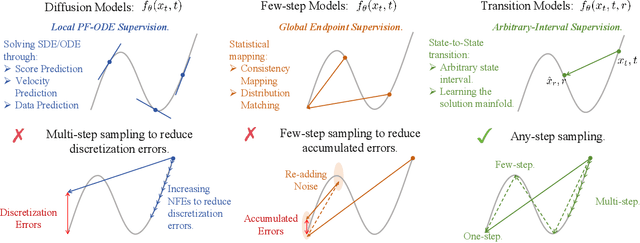

Abstract:A fundamental dilemma in generative modeling persists: iterative diffusion models achieve outstanding fidelity, but at a significant computational cost, while efficient few-step alternatives are constrained by a hard quality ceiling. This conflict between generation steps and output quality arises from restrictive training objectives that focus exclusively on either infinitesimal dynamics (PF-ODEs) or direct endpoint prediction. We address this challenge by introducing an exact, continuous-time dynamics equation that analytically defines state transitions across any finite time interval. This leads to a novel generative paradigm, Transition Models (TiM), which adapt to arbitrary-step transitions, seamlessly traversing the generative trajectory from single leaps to fine-grained refinement with more steps. Despite having only 865M parameters, TiM achieves state-of-the-art performance, surpassing leading models such as SD3.5 (8B parameters) and FLUX.1 (12B parameters) across all evaluated step counts. Importantly, unlike previous few-step generators, TiM demonstrates monotonic quality improvement as the sampling budget increases. Additionally, when employing our native-resolution strategy, TiM delivers exceptional fidelity at resolutions up to 4096x4096.
A Survey of Scientific Large Language Models: From Data Foundations to Agent Frontiers
Aug 28, 2025



Abstract:Scientific Large Language Models (Sci-LLMs) are transforming how knowledge is represented, integrated, and applied in scientific research, yet their progress is shaped by the complex nature of scientific data. This survey presents a comprehensive, data-centric synthesis that reframes the development of Sci-LLMs as a co-evolution between models and their underlying data substrate. We formulate a unified taxonomy of scientific data and a hierarchical model of scientific knowledge, emphasizing the multimodal, cross-scale, and domain-specific challenges that differentiate scientific corpora from general natural language processing datasets. We systematically review recent Sci-LLMs, from general-purpose foundations to specialized models across diverse scientific disciplines, alongside an extensive analysis of over 270 pre-/post-training datasets, showing why Sci-LLMs pose distinct demands -- heterogeneous, multi-scale, uncertainty-laden corpora that require representations preserving domain invariance and enabling cross-modal reasoning. On evaluation, we examine over 190 benchmark datasets and trace a shift from static exams toward process- and discovery-oriented assessments with advanced evaluation protocols. These data-centric analyses highlight persistent issues in scientific data development and discuss emerging solutions involving semi-automated annotation pipelines and expert validation. Finally, we outline a paradigm shift toward closed-loop systems where autonomous agents based on Sci-LLMs actively experiment, validate, and contribute to a living, evolving knowledge base. Collectively, this work provides a roadmap for building trustworthy, continually evolving artificial intelligence (AI) systems that function as a true partner in accelerating scientific discovery.
InternVL3.5: Advancing Open-Source Multimodal Models in Versatility, Reasoning, and Efficiency
Aug 25, 2025Abstract:We introduce InternVL 3.5, a new family of open-source multimodal models that significantly advances versatility, reasoning capability, and inference efficiency along the InternVL series. A key innovation is the Cascade Reinforcement Learning (Cascade RL) framework, which enhances reasoning through a two-stage process: offline RL for stable convergence and online RL for refined alignment. This coarse-to-fine training strategy leads to substantial improvements on downstream reasoning tasks, e.g., MMMU and MathVista. To optimize efficiency, we propose a Visual Resolution Router (ViR) that dynamically adjusts the resolution of visual tokens without compromising performance. Coupled with ViR, our Decoupled Vision-Language Deployment (DvD) strategy separates the vision encoder and language model across different GPUs, effectively balancing computational load. These contributions collectively enable InternVL3.5 to achieve up to a +16.0\% gain in overall reasoning performance and a 4.05$\times$ inference speedup compared to its predecessor, i.e., InternVL3. In addition, InternVL3.5 supports novel capabilities such as GUI interaction and embodied agency. Notably, our largest model, i.e., InternVL3.5-241B-A28B, attains state-of-the-art results among open-source MLLMs across general multimodal, reasoning, text, and agentic tasks -- narrowing the performance gap with leading commercial models like GPT-5. All models and code are publicly released.
CMPhysBench: A Benchmark for Evaluating Large Language Models in Condensed Matter Physics
Aug 25, 2025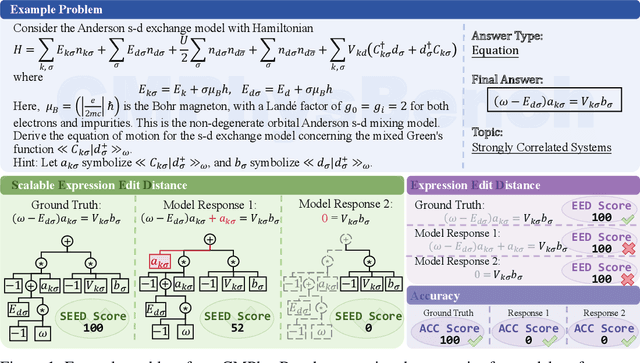
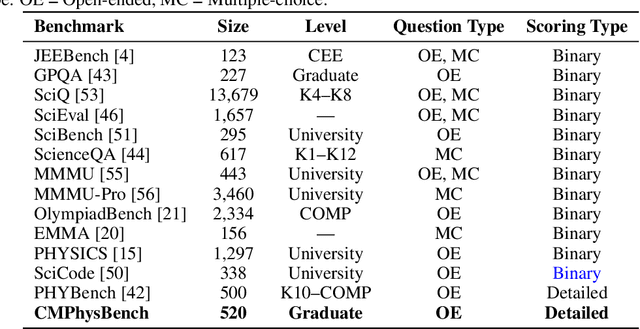


Abstract:We introduce CMPhysBench, designed to assess the proficiency of Large Language Models (LLMs) in Condensed Matter Physics, as a novel Benchmark. CMPhysBench is composed of more than 520 graduate-level meticulously curated questions covering both representative subfields and foundational theoretical frameworks of condensed matter physics, such as magnetism, superconductivity, strongly correlated systems, etc. To ensure a deep understanding of the problem-solving process,we focus exclusively on calculation problems, requiring LLMs to independently generate comprehensive solutions. Meanwhile, leveraging tree-based representations of expressions, we introduce the Scalable Expression Edit Distance (SEED) score, which provides fine-grained (non-binary) partial credit and yields a more accurate assessment of similarity between prediction and ground-truth. Our results show that even the best models, Grok-4, reach only 36 average SEED score and 28% accuracy on CMPhysBench, underscoring a significant capability gap, especially for this practical and frontier domain relative to traditional physics. The code anddataset are publicly available at https://github.com/CMPhysBench/CMPhysBench.
Mimicking the Physicist's Eye:A VLM-centric Approach for Physics Formula Discovery
Aug 24, 2025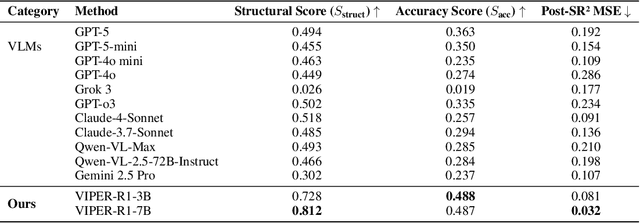
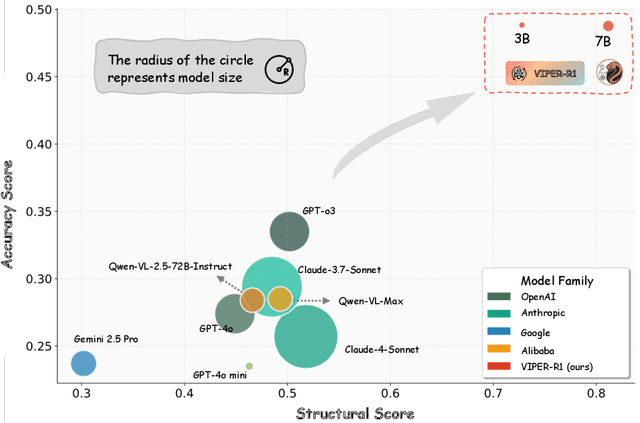

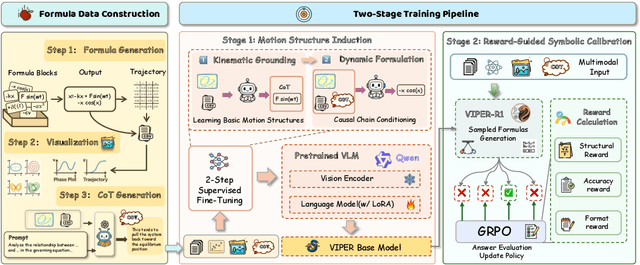
Abstract:Automated discovery of physical laws from observational data in the real world is a grand challenge in AI. Current methods, relying on symbolic regression or LLMs, are limited to uni-modal data and overlook the rich, visual phenomenological representations of motion that are indispensable to physicists. This "sensory deprivation" severely weakens their ability to interpret the inherent spatio-temporal patterns within dynamic phenomena. To address this gap, we propose VIPER-R1, a multimodal model that performs Visual Induction for Physics-based Equation Reasoning to discover fundamental symbolic formulas. It integrates visual perception, trajectory data, and symbolic reasoning to emulate the scientific discovery process. The model is trained via a curriculum of Motion Structure Induction (MSI), using supervised fine-tuning to interpret kinematic phase portraits and to construct hypotheses guided by a Causal Chain of Thought (C-CoT), followed by Reward-Guided Symbolic Calibration (RGSC) to refine the formula structure with reinforcement learning. During inference, the trained VIPER-R1 acts as an agent: it first posits a high-confidence symbolic ansatz, then proactively invokes an external symbolic regression tool to perform Symbolic Residual Realignment (SR^2). This final step, analogous to a physicist's perturbation analysis, reconciles the theoretical model with empirical data. To support this research, we introduce PhysSymbol, a new 5,000-instance multimodal corpus. Experiments show that VIPER-R1 consistently outperforms state-of-the-art VLM baselines in accuracy and interpretability, enabling more precise discovery of physical laws. Project page: https://jiaaqiliu.github.io/VIPER-R1/
SynBrain: Enhancing Visual-to-fMRI Synthesis via Probabilistic Representation Learning
Aug 14, 2025Abstract:Deciphering how visual stimuli are transformed into cortical responses is a fundamental challenge in computational neuroscience. This visual-to-neural mapping is inherently a one-to-many relationship, as identical visual inputs reliably evoke variable hemodynamic responses across trials, contexts, and subjects. However, existing deterministic methods struggle to simultaneously model this biological variability while capturing the underlying functional consistency that encodes stimulus information. To address these limitations, we propose SynBrain, a generative framework that simulates the transformation from visual semantics to neural responses in a probabilistic and biologically interpretable manner. SynBrain introduces two key components: (i) BrainVAE models neural representations as continuous probability distributions via probabilistic learning while maintaining functional consistency through visual semantic constraints; (ii) A Semantic-to-Neural Mapper acts as a semantic transmission pathway, projecting visual semantics into the neural response manifold to facilitate high-fidelity fMRI synthesis. Experimental results demonstrate that SynBrain surpasses state-of-the-art methods in subject-specific visual-to-fMRI encoding performance. Furthermore, SynBrain adapts efficiently to new subjects with few-shot data and synthesizes high-quality fMRI signals that are effective in improving data-limited fMRI-to-image decoding performance. Beyond that, SynBrain reveals functional consistency across trials and subjects, with synthesized signals capturing interpretable patterns shaped by biological neural variability. The code will be made publicly available.
Cut2Next: Generating Next Shot via In-Context Tuning
Aug 12, 2025Abstract:Effective multi-shot generation demands purposeful, film-like transitions and strict cinematic continuity. Current methods, however, often prioritize basic visual consistency, neglecting crucial editing patterns (e.g., shot/reverse shot, cutaways) that drive narrative flow for compelling storytelling. This yields outputs that may be visually coherent but lack narrative sophistication and true cinematic integrity. To bridge this, we introduce Next Shot Generation (NSG): synthesizing a subsequent, high-quality shot that critically conforms to professional editing patterns while upholding rigorous cinematic continuity. Our framework, Cut2Next, leverages a Diffusion Transformer (DiT). It employs in-context tuning guided by a novel Hierarchical Multi-Prompting strategy. This strategy uses Relational Prompts to define overall context and inter-shot editing styles. Individual Prompts then specify per-shot content and cinematographic attributes. Together, these guide Cut2Next to generate cinematically appropriate next shots. Architectural innovations, Context-Aware Condition Injection (CACI) and Hierarchical Attention Mask (HAM), further integrate these diverse signals without introducing new parameters. We construct RawCuts (large-scale) and CuratedCuts (refined) datasets, both with hierarchical prompts, and introduce CutBench for evaluation. Experiments show Cut2Next excels in visual consistency and text fidelity. Crucially, user studies reveal a strong preference for Cut2Next, particularly for its adherence to intended editing patterns and overall cinematic continuity, validating its ability to generate high-quality, narratively expressive, and cinematically coherent subsequent shots.
 Add to Chrome
Add to Chrome Add to Firefox
Add to Firefox Add to Edge
Add to Edge